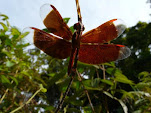Summer's nearly over for the local birds. Well, not quite, but it feels like it - nests are bulging with semi-naked chicks, grotesque with still-shut eyes, scrawny bodies and heads that seem to be attached by the frailest of necks, bills gaping whenever they hear a noise that may signal their parents. Before we know it, they'll all be up and out and off, through a brief danger-filled period of learning about cats, stoats, weasels, Sparrowhawks... those that make it past the predators and manage to find enough food, escape the rain and the cold, miss the cars and the windows and become fit enough to cross the English Channel will be off south to Spain, then North Africa - then for some species the minor matter of crossing the Sahara and finding their way through a whole new suite of predators and dangers, competing for food with the local birds and animals, as well as the northern migrants. And then it will all go into reverse for next year. No wonder so many die in their first year!
Even the local species, those we think of as resident, have a host of obstacles to overcome: predators, food, weather, us, competition from their own and other species... Tough life.
Meadow Pipit nest. OK, this one's not very difficult to pick out, as it's smack in the middle of the photo. Still, how easy would you find it to see when you're tramping across Dartmoor?
From a little closer, you can see the nest at the back of the clump of Molinia... even a vague glimpse of nestlings.
And this is one: Meadow Pipit nestling, at the perfect size for ringing.
Na gets to grips with a Meadow Pipit family
Other species nest off the ground...
And some are the archetypal grotesques... Carrion Crow chicks, for example
A random bit of Dartmoor evening
Judith shows off a Whitethroat chick; about 6-7 days old.
The same Whitethroat back in a brambly-bluebelly nest on the Dartmoor fringe.



















